- Bernard Preston homepage
- Beekeeping
- Guava Honey Mead
Guava honey mead
Guava honey mead is really known as a melomel; it's a wine with a difference.
Let me start off by saying that whilst I've been brewing conventional mead and beer for at least thirty years, this is the first time I have tried making a melomel. We had a glut of guavas this year and were looking for ways to preserve the important phytonutrients in the fruit.
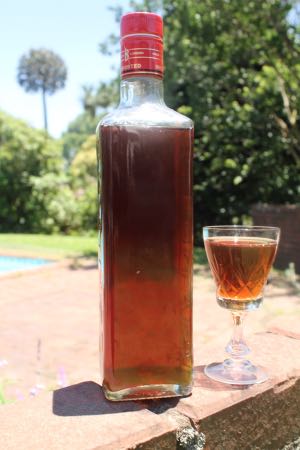
May I add this is really for beekeepers who also have access to large amounts of fruit. If you are going to brew a 23 litre carboy you will need nearly 20 pounds of natural honey; in South Africa that will cost you around R1500 or more.
Beekeepers are always looking for ways to use their "gleanings;" the mixed wax-cappings and honey that are a byproduct of our hobby.
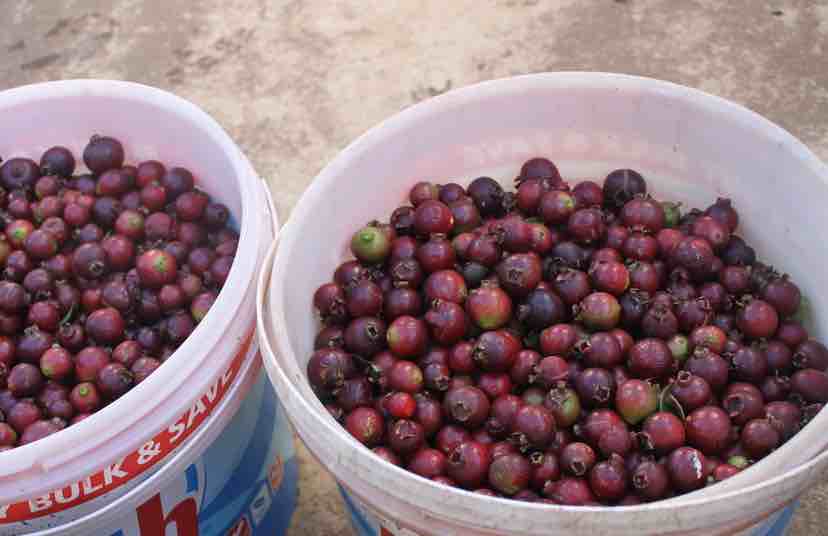
Ingredients
- Guava fruit
- Honey
- Or wet comb and cappings mix[2]
- Large lemon
- 10 cloves
- 1 large ginger-root
- Tea from 20 guava leaves [3]
- 1 sachet yeast[6]
- Yeast nutrient[4]
23 L
- 10kg
- 8kg
- 21kg
- 1
- 10
- 250g
- 20
- 1 tsp VIN13
18L
- 8kg
- 6.3kg
- 16.8
- 4/5
- 8
- 200g
- 16
- 4/5 tsp
8L
- 3.5kg
- 2.8kg
- 7.3
- 1/3 lemon
- 4 cloves
- 90g
- 7 leaves
- 1/3 tsp yeast
4.5 l
- 2kg
- 1.6kg
- 4.2kg
- 1/5
- 2
- 50g
- 4
- 1/5 tsp
I would not go with more than half your honey from the gleanings; it simply takes up too much room in the carboy[5].
Or what I now do is add warm water to the gleanings, mash it up thoroughly and strain off the dissolved honey. Then add a small chunk of comb; puncture all the cells first so the water and yeast can permeate the wax.
Go for it
I made this batch of guava honey mead, or melomel to be more precise on 4th May, 2022; and the latest one on 14th April, 2025.
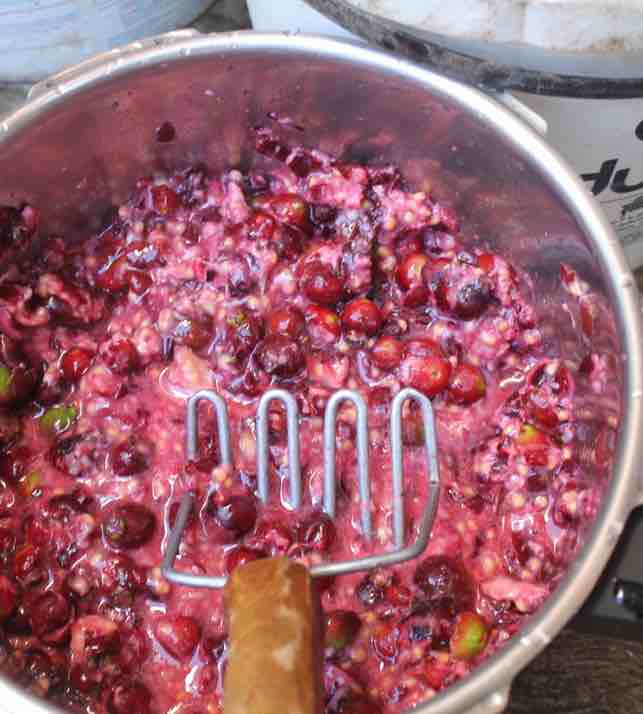
- Sanitise all the equipment.
- Wash the very ripe fruit.
- Place the mashed fruit in a bag in the fermenter with a few heavy river pebbles so that it doesn't float; in this instance a 23 litre carboy.
- Add the lemon chopped into slices; first remove the pips, pith and skin.
- Make a tea with 1 litre of unchlorinated water and brew the guava leaves for 15 minutes.
- Add to the fermenter.
- Add the cloves and chopped-up ginger.
- Place honey or wet comb into a bucket and using 10 litres water agitate with your creamer until comb is well broken up; filter. Place the dissolved honey into the carboy with the fruit. Ensure there is at least a 10cm space between the top of the liquid and the lid; it will start foaming once fermentation starts. Watch carefully that it does not overflow in warm weather.
- Measure the acidity and SG; and taste.
- Add 1 tsp white-wine yeast for every 5 litres of must[6]; stir into warm water at 35*C and pour it in after 20 minutes; add the nutrient, or a small block of comb, say 5cm, that is full of fresh pollen.
- Fit the seal and air-trap.
- Ferment for 6 days then agitate vigorously to break the guava up even more; then after two weeks remove the fruit pulp and allow the bubbling to continue.
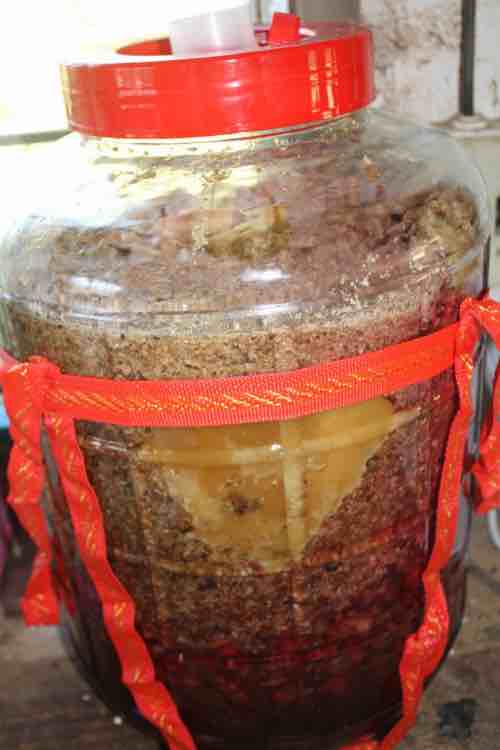
6 weeks stage
- After 6 weeks test the pH again.
- If a plastic fermenter is being used, rack now into glass demijohns.
- Fill the gap above the liquid with a syrup made from a ratio of 1 litre of water to130g fructose.
- Leave for 12 weeks.
12 weeks stage
- After 12 weeks or when fermentation has finished, do SG and pH tests again.
- Then siphon the liquid from the fermenter into a demijohn, trying to avoid the sediment.
- If it is clear and tastes good, bottle; it will likely need to be racked again.
Acidity
The pH range you want is 3,5 to 4,5. Add 1.25ml of bicarb or tartaric acid per 0.5 adjustment on 5 litres in tranches; it may bubble over.
After mixing the powder in, recheck the pH. I usually do my adjustments before fermentation but have needed to do it again at racking sometimes.
I am now using calcium carbonate as it is less salty.
Add 1.25ml of sodium bicarbonate per 0.5 adjustment on 5 litres.
To raise the pH from 2.0 to 3.5 one would need 3 x 1.25ml = 3.75; about half a teaspoon.
If your pH is 3 add 3.75ml Bicarb. If it is 5 then add 3.75 ml Tartaric acid, both in powder form. Stir doing your best not to let air into the mixture.
Air will start an oxidisation process, which might end up with a vinegar. It will then be nice on salads but not for consuming as your evening tipple.
Question and answer
Cherry guavas are almost all pips. I take it something in the seeds would detract from the melomel. Is that correct? Is using the whole fruit at the fermentation stage detrimental?
In all fruits the pips have an oil they emit during fermentation; you could try leaving them in. It may become rancid. Going the “all hive” route it is best; put the fruit pulp in a muslin bag and remove it after two weeks.
The fruit pulp can then be used for making jam; in a sense during fermentation it has been pickled.
I use this device for creaming honey. Would it do, or should I make another with a shorter paddle?
The one you use to cream your honey should be fine. However if you can get a stainless-steel paint stirrer, it’ll be even better.
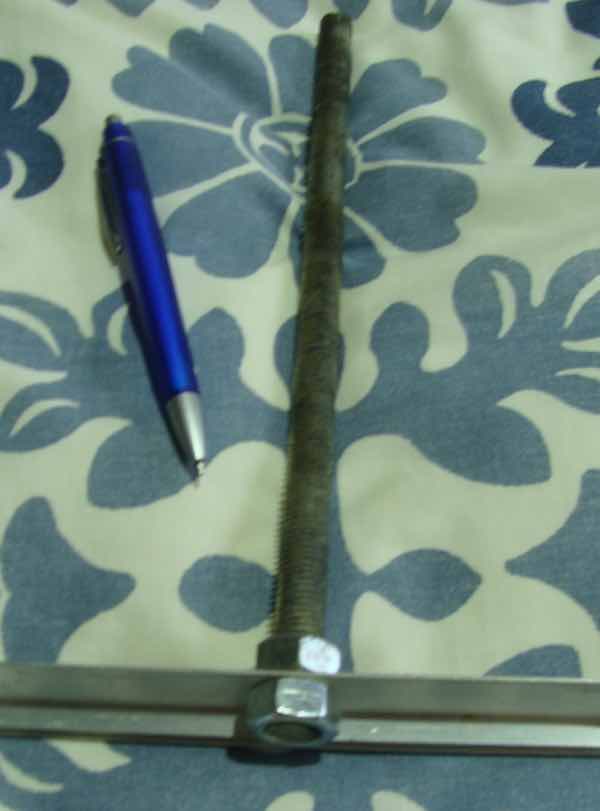
Roughly how many grams of ginger would you use? Or how long a root is best?
A root about the size of your hand, cut in slices of about 3mm is best. Remember to remove the skin. It can be scrapped off using a serrated-knife.
In general how large a space is left between the liquid and the cork in a demijohn?
I wouldn’t use a demijohn for this; either a bucket or a 25 litre wide-mouthed carboy. Almost a quarter of the height of the vessel must be clear. The gas production lifts the mass of cappings right out of the liquid. Alternatively you can agitate every few hours to keep the floating wax below the surface of the fermenting hydromel. However this needs to be done very carefully. You do not want to add oxygen as this will spoil things.
So the time interval is not cast in stone. At first racking can be anything from 3 to 12 weeks from start.
The secondary fermentation is to allow the mead to mature.
A guava honey mead like this can be ready to drink from 18 weeks from the start; about 4 months.
Cappings can be left on for a long time, or you can separate them after 3 weeks.
If your SG is too high you can add water. Just make sure it has been boiled.
It might be an idea to make a box with polystyrene to house the mead. Going below 18°C might cause the ferment to get stuck; or have an infra-red light shining onto the carboy to warm it up at night.
Racking
All yeast products have a mind of their own, just talk to bakers, but these are the guidelines for when to rack your mead.
- I usually do my first rack 6 - 12 weeks after making it.
- I rack it a second time after it is clear, which could be 6 - 12 months later.
- If it was very clear when I started my 2nd rack, then after a week or two would move to bottling.
- If not clear then another rack when it is clear, followed by bottling.
Racking of the guava honey mead is done to separate the liquid from the dead yeast cells that have settled at the bottom.
The first racking is usually done after some 2 to 3 months; usually it will be quite murky with small particles in suspension. Check and adjust the pH.
The second rack is done after it clears, usually 6 to 12 months later. One could then bottle after a few weeks.
A third racking may be necessary a few months later if it hasn't cleared.
Ask anyone who bakes or brews; yeast has a mind of its own. Sometimes it starts bubbling again months after it has cleared and you would have thought that all fermentation had ceased.
There is no reason not to start drinking your guava honey mead whilst it's still murky. It is an excellent probiotic; those yeast cells simply contribute to the normal flora in the gut.
Guava honey mead
Guava honey mead can only realistically be made if you have easy access to natural honey and the fruit; a wonderful aperitif.
Should you feel tempted to brew your own, this is the basic mead equipment you will need.
Honey judges guild of south africa
"Congratulations go to Chris Schoeman, Hamish Gebers and Ronel Swanepoel; to Steve Koekemoer, Montpellier Bees and Bernard Preston too. Ian Thompson, Ursula Herbst and the Urban Apiary also entered outstanding mead exhibits."
- Gauteng Honey and Mead competition, 2023
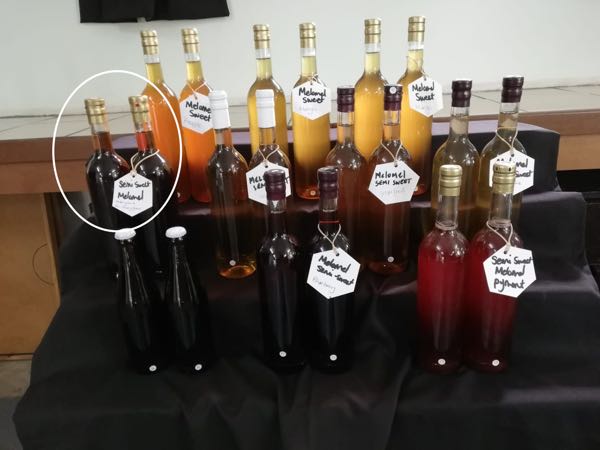 The best meads in South Africa
The best meads in South AfricaHighly commended
- Presentation
- Appearance
- Bouquet
- Taste
- After taste
- Debris in the neck
- Hazy
- Lovely aroma
- Lovely taste
- Great after taste
- 7/10
- 7/10
- 20/20
- 28.5/30
- 30/30
92.5/100
After only 8 months it comes as no surprise it had not cleared and was hazy. A good mead like a mature whiskey really should not be showed (or drunk) until at least one year old; and preferably five.
Tips
I have now been brewing this cherry guava melomel for several years; it's my favourite.
- The fruit takes up a lot of space in the carboy; less mead. I now pulp the cherry guavas, place 1/3 in the bag with the ginger, lemon and pebbles; and then mush with repeated additions of small amounts of water to extract the rest of the juice. There will be some loss of nutrient value.
- Add enough river pebbles to the bag of fruit so it really does sink. There's a natural buoyancy of the guavas plus the lift from the CO2; more stones than you would expect.
- Leave a good 5cm gap or even more at the top; and then add the tea after a couple days. This helps to prevent the mead from bubbling over.
- Add rather less yeast than more.
- I don't think a yeast nutrient is needed if you are using lightly-filtered honey, already rich in pollen and fruit.
Light hops mead
I made a light 2% mead with hops added, cold at start with 10ml of lemon juice for each litre; and then fermented with ten grams honey/0.75 L per bottle and got a lovely summer thirst-quencher.
- Gert van der Waal
- What is Melomel Mead?
- 8kg gleanings + 3kg honey
- Boil for 15 minutes in rain or spring water
- Or small chunk of comb containing fresh pollen
- Or mash up the cappings with warm water and strain off the dissolved honey.
- Since having trouble with the must foaming over, I have been using less yeast. 1tsp VIN13 in 23L
When browsing use right click and "Open Link in New Tab" or you may get a bad gateway signal.
Newsletter
Our newsletter is entitled "create a cyan zone" at your home, preserving both yourself and Mother Earth for future generations; and the family too, of course. We promise not to spam you with daily emails promoting various products. You may get an occasional nudge to buy one of my books.
Here are the back issues.
- Lifestyle and ideal body weight
- What are ultra-processed foods?
- Investing in long-term health
- Diseases from plastic exposure
- Intensive lifestyle management for obesity has limited value
- A world largely devoid of Parkinson's Disease
- The impact of friendly bacteria in the tum on the prevention of cancer
- There's a hole in the bucket
- Everyone is talking about weight loss drugs
- Pull the sweet tooth
- If you suffer from heartburn plant a susu
- Refined maize meal and stunting
- Should agriculture and industry get priority for water and electricity?
- Nature is calling
- Mill your own flour
- Bake your own sourdough bread
- Microplastics from our water
- Alternative types of water storage
- Wear your clothes out
- Comfort foods
- Create a bee-friendly environment
- Go to bed slightly hungry
- Keep bees
- Blue zone folk are religious
- Reduce plastic waste
- Family is important
- What can go in compost?
- Grow broad beans for longevity
- Harvest and store sunshine
- Blue zone exercise
- Harvest and store your rainwater
- Create a cyan zone at your home
Did you find this page interesting? How about forwarding it to a friendly book or food junkie? Better still, a social media tick would help.
- Bernard Preston homepage
- Beekeeping
- Guava Honey Mead
Address:
56 Groenekloof Rd,
Hilton, KZN
South Africa
Website:
https://www.bernard-preston.com